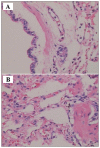Curative effect of pleural lavage on open chest trauma caused by seawater immersion
- PMID: 23793432
- PMCID: PMC6078528
- DOI: 10.5144/0256-4947.2013.277
Curative effect of pleural lavage on open chest trauma caused by seawater immersion
Abstract
Background and objectives: Open chest trauma with seawater immersion can lead systematic inflammatory response and multiple organ dysfunction syndromes (MODS). Early intervention of seawater immersion significantly decreases mortality. This study aims to explore the curative effect of pleural lavage in the treatment of open chest trauma caused by seawater immersion on dogs.
Design and settings: An in vivo experimental study was performed in healthy cross-breeding adult dogs (n=20).
Subjects and methods: A dog model of open chest trauma caused by seawater immersion was established. All experimental dogs were divided into control group and pleural lavage group, with 10 dogs in each group. In the control group, dogs were performed ventilator-assisted breathing, and thoracic tube was kept open for adequate chest water drainage; in the pleural lavage group, dogs were further injected with 0.9% sodium chloride (35 mL/kg) immediately into the right side of the chest after the pleural effusion was drained off. The internal environment, oxygen partial pressure, and pathological changes of the lung tissue were observed and recorded.
Results: Following open chest trauma caused by seawater immersion, both groups showed obviously increased serum sodium and plasma osmolality and sharply decreased oxygen partial pressure. After treatment, the serum sodium and plasma osmolality decreased, whereas oxygen partial pressure increased in both groups. The pleural lavage group showed better improvement than the conventional treatment group. The pathological changes in the pleural group were lighter than in the conventional treatment group.
Conclusion: Compared with conventional treatment, repeated pleural lavage shows improved treatment in the correction of blood hypertonic state and hypoxemia in seawater-immersed open chest trauma.
Figures



Similar articles
-
[Multiple organ dysfunction syndrome after open chest wound and seawater immersion: experimental study].Zhonghua Wai Ke Za Zhi. 2000 Aug;38(8):630-2. Zhonghua Wai Ke Za Zhi. 2000. PMID: 11832127 Chinese.
-
Effect of seawater immersion on plasma osmotic pressure and electrolyte balance following open chest trauma.Chin J Traumatol. 2002 Aug;5(4):219-23. Chin J Traumatol. 2002. PMID: 12162899 Clinical Trial.
-
[Experimental treatment of acute lung injury caused by inundation of thoracic cavity by seawater following open chest wound].Zhongguo Wei Zhong Bing Ji Jiu Yi Xue. 2007 Apr;19(4):197-200. Zhongguo Wei Zhong Bing Ji Jiu Yi Xue. 2007. PMID: 17448270 Chinese.
-
[Pleural drainage in trauma].Lakartidningen. 2004 Jun 3;101(23):2016-8, 2021-2. Lakartidningen. 2004. PMID: 15232840 Review. Swedish. No abstract available.
-
Case scenario - thoracic trauma.Ann Fr Anesth Reanim. 2013 Jul-Aug;32(7-8):504-9. doi: 10.1016/j.annfar.2013.07.009. Epub 2013 Jul 31. Ann Fr Anesth Reanim. 2013. PMID: 23916516 Review.
References
-
- Li H, Lu E, Yu J, Wang Y, Sun X, Wang D, et al. Multiple organ dysfunction syndrome after open chest wound and seawater immersion: experimental study. Zhonghua Wai Ke Za Zhi. 2000;38:630–2. Chinese. - PubMed
-
- Haiqin Xu, Bo Feng, Shixia Xu, et al. Seawater Immersion Wound and Seawater Drowning Bibliometric Analysis. Chinese Journal of Nautical Medicine and Hyperbaric Medicine. 2010;17:88–91.
-
- Zellweger R, Navsaria PH, Hess F, Omoshoro-Jones J, Kahn D, Nicol A. Transdiaphragmatic pleural lavage in penetrating thoracoabdominal trauma. Br J Surg. 2004;91:1619–23. - PubMed
-
- Ye RG, Lu ZY, Xie Yi, et al. Internal Medicine. 6th edn. Beijing: People’s Medical Publishing House; 2006. pp. 842–3.
-
- Onan B, Demirhan R, Öz K, Onan IS. Cardiac and great vessel injuries after chest trauma: our 10-year experience. Ulus Travma Acil Cerrahi Derg. 2011;17:423–9. - PubMed
MeSH terms
Substances
LinkOut - more resources
Full Text Sources
Other Literature Sources
Medical

